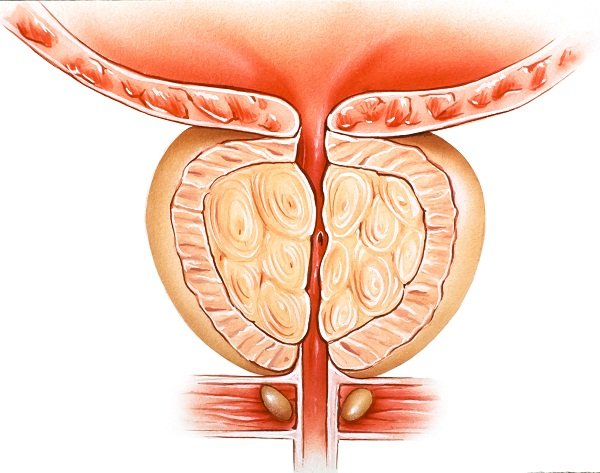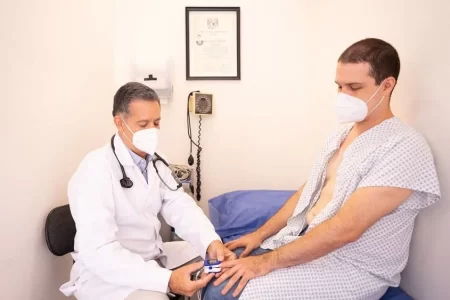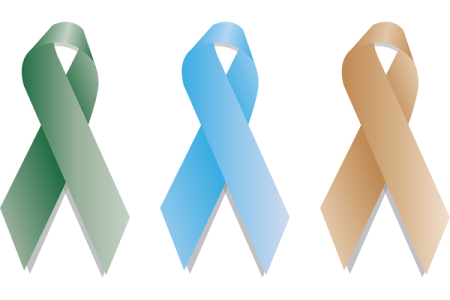DiseaseFix’s every article is examined by board-certified medical professionals to ensure that details on conditions, symptoms, treatments, and protocols comply with current guidelines and recent research. Our content is also written, verified, and approved by a team of experienced writers, editors, clinicians, and other experts.
Understanding About Prostate Gland in Men
- Updated on: Jul 12, 2024
- 5 min Read

What is prostate gland?
The prostate gland is a chestnut-shaped male reproductive organ. The prostate is not one but many glands (about 30-50 in number), between which is abundant tissue containing bundles of smooth muscles.

Prostate secrete a milky fluid that is discharged into the urethra at the time of the ejaculation of semen.
The word prostate is derived from the Greek word “prostates”, which means to stand before. Well known anatomist Herophilus called it the prostate as it stands before the testes. In this article, we will explain about how to become more aware of your prostate health and prostate condition.
How big is the prostate gland? What is prostate size?
The size of your prostate varies as you grow in age. In normal adults, the average size of the prostate gland is about the size of a walnut, but it can become significantly bigger in older men. When you are about the age of 40, the prostate gland starts to enlarge as a result of a condition called benign prostatic hypertrophy (BPH).
What Size and weight is my prostate supposed to be?
A healthy adult prostate weighs about 20–25 grams. Its dimensions measure 4 x 2 x 3 centimeters (1.6 x 1 x 1.2 inches).
Normally, the prostate gland reaches its mature (normal) size at puberty, between ages 10 and 14. Around age 45-50, the size of the prostate and the amount of its secretions generally decrease.
Where is the prostate located? Prostate gland location and anatomy.
The prostate gland is located between the bladder and the penis. The prostate lies just in front of the rectum. The urethra runs through the center of the prostate, from the bladder and to the penis, allowing urine to flow out of the body through urethra.
The gland surrounds the urethra, the tube through which both urine and semen passes. The gland is rounded at the top and narrows to a blunt point at the bottom, called apex.
The diameter of prostate in the broadest area is about 4 cm (1.6 inches). The two ducts, which carry sperm and the fluid secreted by the seminal vesicles, converge in the centre of the prostate and joins the urethra.
The prostate is encapsulated with a structure composed of collagen, elastin and smooth muscle. The prostate is covered by 3 distinct layers of fascia on the anterior, lateral, and posterior aspects.
In normal cases, the prostate become mature in size at puberty, at about the ages of 10-13. At an age of 50, the size of the prostate and the amount of fluid secreted by it decreases. Enlargement of the prostate in old age often makes urination difficult.
Prostate is present only in males. The Skene gland (paraurethral gland) in females, located at the lower end of the urethra, is generally considered homologous to the prostate gland in males and is sometimes referred to as the female prostate.
How does a prostate gland develop?
The prostate develops from epithelial outgrowths. This outgrowth starts at about week 10 during embryo growth. By around 12th week, there are five groups of tubules that form the lobes of the prostate. The first group forms the middle lobe, the second and third groups develop the right and left lateral lobes, the fourth group forms the posterior lobe, and the fifth group forms the anterior lobe.
What are the zones of the prostate?
The prostate gland is formed of different types of tissues that are grouped into different classes called prostate zones. There are three prostate zones as follows:
- The peripheral zone contains the majority of prostatic glandular tissue. The largest area of the peripheral zone is located at the back side of the prostate and is closest to the rectal wall. About 70-80% of prostate cancers originate in the peripheral zone, therefore this region hold significant importance in medicine.
- The central zone surrounds the ejaculatory ducts. Only about 5% of prostate cancers begin in this region. But the cancers that originate from the central zone are considered more aggressive.
- The thirs zone called the transition zone surrounds the urethra as it enters the prostate gland. It is small in size in younger people, but it grows with age. It constitutes significant portion of the gland in older age. It is responsible for a condition in old men called benign prostatic hyperplasia (BPH). About 20% of prostate cancers begin from the central zone.
Blood and nerval supply to the prostate gland (Histology): Vascular and Nerve Supply of the Prostate
The branches of internal iliac vessels supply blood to the prostate.
Arteries of the prostate
The inferior vesical artery reaches the prostate from laterodorsal and divides into urethral and capsular branches. The urethral branches supply blood to the transition zone.
Capsular branches meet the cavernous nerves posterolateral of the prostate. Small arteries branch off and perforate through the organ capsule. Branches from the middle rectal artery, internal pudendal artery or obturator artery additionally provide the supply.
Veins of the prostate
The blood from the glands drains through the vesicoprostatic plexus to the internal iliac veins.
Nerves of the prostate
The autonomic innervation meets the prostate via the cavernous nerves and perforates together with the arterial branches of the capsule of the prostate. The cavernous nerves passes between the capsule of the prostate and the fascia of the levator ani muscle latero-posterior to the prostate.
Parasympathetic signals stimulate glandular activity.
Prostate gland function: What does prostate gland do?
The prostate secretes a fluid that is responsible primary for the nourishment and protection of the sperm. During ejaculation, the prostate pushes this fluid into the urethra, which is expelled with sperm as semen.
During ejaculation, millions of sperm travel from the testes through small tubes called the vas deferens into the prostate region. The prostate then contracts, closing off the opening between the bladder and the urethra, to release the fluid into the urethra and push the semen through.
The fluid excreted by the prostate makes up about one-third of the total volume of semen. The fluid contains various enzymes, zinc and citric acid. The prostate fluid is slightly acidic in nature, but another fluid in the semen produced by the seminal vesicles makes the semen a bit alkaline. This alkalinity helps to protect the sperm and prolong their life as they have to stay in the acidic environment of the vagina.
Common diseases and conditions of the prostate
Most men experiences urinary symptoms as they grow old. This may be due to the inflammation of the prostate gland (prostatitis) or other prostate problems.
In older male, symptoms may be the result of a blockage in the urethra due to a benign (non-cancerous) enlargement of the prostate gland. The most common symptom is difficulty in emptying your bladder.
Though not all urinary symptoms are due to changes in the prostate, but in many men, the primary reason is linked to the prostate gland.
These are the most common diseases of the prostate gland:
- Prostatitis: Inflammation of the prostate, generally caused by infection and can be diagnosed with blood test.
- Enlarged prostate: Also called benign prostatic hypertrophy or BPH, in which prostate growth affects almost all men over 50.
- Prostate cancer: It’s the most common form of cancer in men after skin cancer, but is comparatively less fatal. Various tests for prostate cancer exist that can help detect the condition such as prostate biopsy.
FAQs
What is the role of the prostate gland in men's health?
The prostate gland plays a crucial role in male reproductive health by producing seminal fluid that nourishes and transports sperm.
How does age impact the prostate?
As men age, the prostate can undergo changes, potentially leading to conditions like benign prostatic hyperplasia (BPH) or prostate cancer. Regular check-ups are essential.
Can lifestyle choices affect prostate health?
Yes, maintaining a healthy lifestyle with a balanced diet and regular exercise can contribute to overall prostate health and reduce the risk of prostate-related issues.
What are the common symptoms of prostate problems?
Symptoms may include difficulty urinating, frequent urination, and pain. Early detection through regular screenings is crucial for effective management.
Are there preventive measures for prostate issues?
Adopting a healthy lifestyle, undergoing regular check-ups, and being aware of family history can aid in preventing or managing prostate-related problems.












